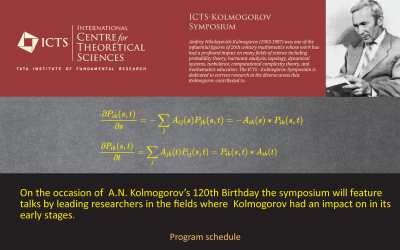On the occasion of A.N. Kolmogorov’s 120th Birthday the symposium will feature talks by leading researchers in the fields where Kolmogorov had an impact on in its early stages.
Zoom link: https://icts-res-in.zoom.us/j/84556101498?pwd=ZU9HU0YzcnhZR1ZqcU9EWC81Vm9rUT09
Meeting ID: 845 5610 1498
Passcode: 252523
Hao Wu (Tsinghua University) - Probability Theory
Time: 15:00 to 15:30
Title:Connection probabilities for 2D critical lattice models
Abstract:Conformal invariance of critical lattice models in two-dimensional has been vigorously studied for decades. The first example where the conformal invariance was rigorously verified was the planar uniform spanning tree (together with loop-erased random walk), proved by Lawler, Schramm and Werner around 2000. Later, the conformal invariance was also verified for Bernoulli percolation (Smirnov 2001), level lines of Gaussian free field (Schramm-Sheffield 2009), and Ising model and FK-Ising model (Chelkak-Smirnov et al 2012). In this talk, we focus on critical Ising model and give the crossing probabilities of multiple interfaces. Such probabilities are related to solutions to BPZ equations in conformal field theory.
Samriddhi Sankar Ray (ICTS-TIFR) - Turbulence
Time: 15:30-16:00
Title: What Turbulence owes to A. N. Kolmogorov?
Abstract: We will discuss the context first and then summarise Komgorov’s seminal contributions in shaping our understanding of statistically, homogeneous, and isotropic turbulence.
If time permits, we will also illustrate how some of his ideas, over half a century ago, have been revised and reinterpreted in light of more recent results in this field.
Prahladh Harsha (TIFR) - Complexity
Time: 16:00-16:30
Title: High Dimensional Expanders and some recent applications
Abstract: The notion of expander graphs was independently discovered by Kolmogorov and Barzdin in 1967 in the context of neural networks and graph embeddings in R^3 and Pinsker in 1973 in the context of telephone networking. Loosely speaking, an expander graph is an extremely well-connected graph despite being sparse. Since then, expander graphs have played a pervasive role in almost all areas of theoretical computer science.
Recently, various high-dimensional analogues of these objects have been studied in mathematics and even more recently, in computer science, motivated by their applications to property testing, coding theory and approximate counting. In this talk, I'll give a high-level introduction to these high-dimensional expanders (HDXs). In particular, we will view them through the perspective of random walks on graphs. Time permitting, we will then see some applications of these HDXs towards matroid counting and coding theory.
Amit Apte (ICTS-TIFR, on lien at IISER Pune) - Dynamical Systems
Time: 16:30-17:00
Title: KAM theory: a (finite-dimensional) perspective
Abstract: The KAM theory is a broad set of tools to understand qualitatively and quantitatively the behaviour of Hamiltonian systems under perturbations. This talk will attempt to outline some of the key developments in KAM theory for finite dimensional systems since the 1954 ICM talk of Kolmogorov that started and shaped the subject.
Alison Etheridge (Oxford University) - Probability Theory
Time: 17:00-17:30
Title: Forwards and backwards in spatially heterogeneous populations
Abstract: Building on the fundamental work of Kolmogorov and his school, we introduce a broad class of mechanistic spatial models that might describe how spatially heterogeneous populations live, die, and reproduce. Questions that we (start to) address include: how does the population density change across space and time? And how does genetic ancestry spread across geography when looking back through space and time in these populations?
Riddhipratim Basu (ICTS-TIFR) - Probability Theory
Time: 17:30-18:00
Title: The bigeodesic problem
Abstract: Whether or not a bi-infinite geodesic exists in random metric spaces is a well-known question whose origin is attributed to Furstenberg in the context of first passage percolation in Euclidean lattices. While this question still remains open, we shall review some related recent progress including ones in planar exactly solvable settings.
S.R.S. Varadhan (Courant Institute of Mathematical Sciences, NYU) and K.R. Parthasarathy (Indian Statistical Institute) - Probability Theory
Time: 18:00-18:30
Title: Memories and Overview


